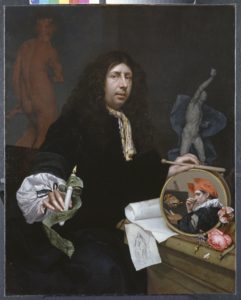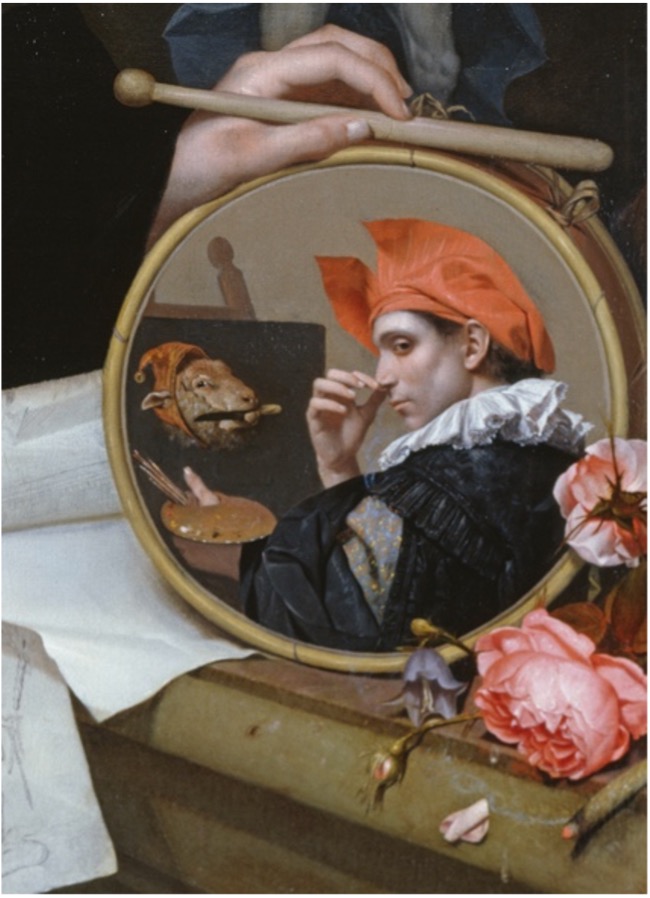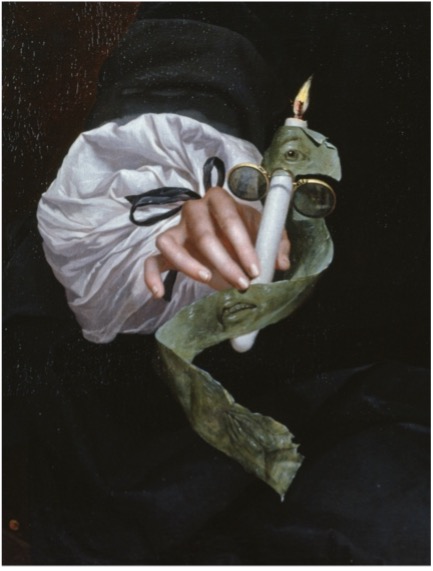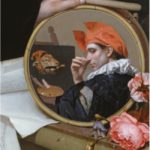A Sensory Manifesto
Johannes van Wijckersloot (c.1625/30–1687), Self-Portrait,
1669, oil on canvas, 114.8 x 91.8 cm,
Museum der bildenden Künste, Leipzig (Maximilian Speck von Sternburg Stiftung).
© bpk | Museum der bildenden Künste, Leipzig | Ursula Gerstenberger
A man sits before the viewer framed by two sculptures: a painting of a red Medici Venus, and the Borghese gladiator, shrouded by its blue packaging. The sitter’s hands are precariously balancing a collection of objects. In his right hand, he presents a lit candle animated by the pair of spectacles, with an eye peering over them, illustrated on a ribbon of paper. Further down the length of paper is a drawing of a mouth, and at the paper’s end are hands in prayer. On the stone plinth is a scrolled architectural drawing, and a loose sheet depicting an allegorical figure, holding a shield decorated with a Janus head, and a blazing torch and rope. There is also a bellflower and pink roses, with a petal and dewdrop mid-fall, and a piece of smouldering rope giving off smoke fumes. In the sitter’s other hand, he holds a drum and a drumstick. The drum skin depicts an artist in the course of painting a sheep’s head wearing a fool’s cap, with a dagger in its mouth. The young artist is disturbed from his work as he pinches his nose and turns to look at the source of the smell. In an extraordinary feat, the smoke from the rope has snaked into another painted dimension, where the young artist resides, compelling him to react to the disruptive scent.
This remarkably cryptic and self-conscious self-portrait was produced by the artist Johannes van Wijckersloot (c.1625/30–1687) in 1669 while head of the Utrecht painting school; a position in which he served for five years. Before assuming the role of dean the following year, Van Wijckersloot may have expressed in his self-portrait his principles as leader of the school. In other words, the painting could be regarded as a visual manifesto, and it might read as follows:
An excellent painting is one that supersedes all other artforms. Painting can bend architecture by coiling it into a scroll. And it can swiftly draw the paragone to its conclusion by colouring the Medici Venus red, and rendering the gladiator’s paper-thin wrapping, which a chisel could only aspire to carve.
An excellent painting can outwit a fellow artist. The classical artist Zeuxis tricked birds with his painted grapes, but his rival Parrhasius painted a curtain so naturally that it deceived Zeuxis. To convince a fellow artist was painting’s true victory, and as the young artist twists to pinch his nose at the painted fumes, Van Wijckersloot has won.
An excellent painting is able to depict what reality can never achieve. The roses, finely painted, have defied time by staying as fresh now as they were over three centuries ago, and the fumes are able to infiltrate between spaces, by seeping from Van Wijckersloot’s realm into the painted drumskin where the young artist paints.
An excellent painting stimulates the entire sensorium. The sketched eye that looks up from the spectacles alludes to Sight, the parted mouth refers to Taste, and the clasped hands represent Touch. The hand drum stands for Hearing, while the blooms and smouldering rope depict Smell. An affirmative gesture from the young artist declares that this masterful painting engages his eyes as well as his nose. Whether the painted fumes can seep into our space to engage our senses, to compel us to feel the painted textures and smell the roses, and the smoke; Van Wijckersloot returns our gaze, and answers that it is up to us to perceive them.
Lizzie Marx
Department of History of Art
University of Cambridge
Bibliography
Bok, M. J., G. Jansen, ‘De Utrechtse schilder Johannes van Wijckersloot en zijn ‘Allegorie op de Franse invasie’’, Bulletin van het Rijksmuseum, Vol.XLIII, No.4, 1995, pp. 336–349.
Hartleb, R., ‘Jan van Wijckersloot: Selbstbildnis, 1669’, in H. Guratszch (ed.), Maximilian Speck von Sternburg: Ein Europäer der Goethezeit als Kunstsammler, Maximilian Speck von Sternburg Stiftung, Leipzig, 1998, pp. 172–174, cat. I/121.
Marx, L., ‘Odours in Art – Depicting the Invisible’, in A. van Suchtelen (ed.), Fleeting – Scents in Colour (exh. cat.), Mauritshuis, The Hague, 2021, pp. 47–52.
Nicolaisen, J., ‘Selbstbildnis’, in Niederländische Malerei 1430–1800, Museum der bildenden Künste Leipzig, Leipzig, 2012, p. 335, cat. 366.
De Vries, L., ‘Een portret van Gerard Ter Borch?’, in Gerard te Borch: Zwolle 1617 – Deventer 1681 (exh. cat.), Mauritshuis, The Hague, 1974, pp. 43–45.




